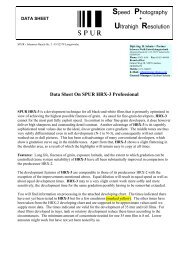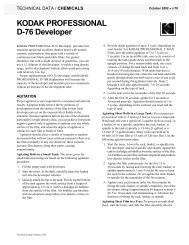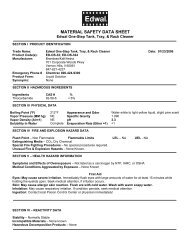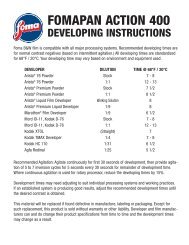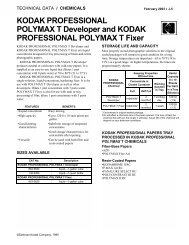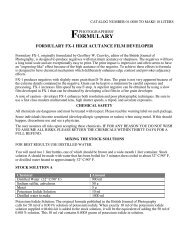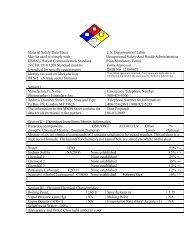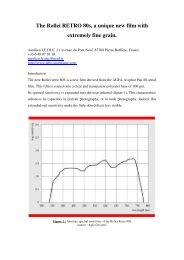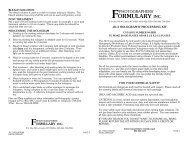Technical Data Agfa Professional Films - Digitaltruth Photo
Technical Data Agfa Professional Films - Digitaltruth Photo
Technical Data Agfa Professional Films - Digitaltruth Photo
Create successful ePaper yourself
Turn your PDF publications into a flip-book with our unique Google optimized e-Paper software.
<strong>Technical</strong> <strong>Data</strong><br />
<strong>Agfa</strong> <strong>Professional</strong> <strong>Films</strong><br />
-1<br />
400 500<br />
In professional photography and creative imaging the main<br />
considerations are quality, continuity and individuality. For<br />
these reasons the films for this area are measured by special<br />
standards. A film only satisfies these high standards if its<br />
performance is above-average. And it will only be accepted if<br />
it achieves this performance with extreme accuracy, consistency<br />
and with the maximum reliability. The wide range of<br />
professional applications calls for a correspondingly wide range<br />
of different emulsions, whose characteristics must be designed<br />
exactly for specific areas of use.<br />
<strong>Agfa</strong> <strong>Professional</strong> films are specified to satisfy these exceptional<br />
standards. They combine the maximum quality with<br />
maximum reliability: optimum colour saturation and tonal<br />
definition, exact contrast ranges, exemplary grey balance, the<br />
finest detail rendition in the critical highlight and shadow<br />
areas, extreme sharpness and fine granularity, and uniform<br />
exposure requirements at short and long exposure times.<br />
Two examples of extremely tight production tolerances:<br />
speed: ± 0.5 DIN = ± 1/6 stop<br />
colour balance: ± 5 CC filter units<br />
<strong>Agfa</strong>color Optima 100<br />
<strong>Agfa</strong>color Optima 200<br />
<strong>Agfa</strong>color Optima 400<br />
<strong>Agfa</strong>color Portrait 160<br />
<strong>Agfa</strong>chrome RSX II 50<br />
<strong>Agfa</strong>chrome RSX II 100<br />
<strong>Agfa</strong>chrome RSX II 200<br />
<strong>Agfa</strong>pan APX 100<br />
<strong>Agfa</strong>pan APX 400 *<br />
<strong>Agfa</strong> Scala 200x<br />
* new generation (as of 2003)
<strong>Agfa</strong>color Optima with EYE VISION technology<br />
A film's colour rendition is governed by a number of factors. The<br />
emulsions' spectral sensitivity or sensitisation is particularly<br />
important, when it comes to reproducing true-to-nature colours<br />
with the maximum accuracy. By means of the EYE VISION<br />
technology incorporated in all the <strong>Agfa</strong>color Optima films, it is<br />
now possible to match, to a large extent, the films' sensitisation<br />
to the colour perception of the human eye. The effect is shown<br />
schematically in the following diagrams. The EYE VISION<br />
technology achieves more accurate colour fidelity, and largely<br />
eliminates the colour falsifications present in films with<br />
conventional sensitisation such as:<br />
• an unpleasant green cast with fluorescent light (e.g. neon tubes),<br />
• a shift towards red in certain blue-coloured flowers (hortensia,<br />
clematis, delphinium etc.),<br />
• the brown rendition of particular green fabric colours,<br />
• the absence of texture in certain red colours (e.g. roses).<br />
Spectral sensitivity of the eye<br />
blue green red<br />
400 450 500 550 600 650 nm<br />
Spectral sensitivity of the film emulsions<br />
400 450 500 550 600 650 nm<br />
<strong>Agfa</strong> <strong>Professional</strong> film range<br />
<strong>Agfa</strong>color negative films:<br />
• Optima 100<br />
• Optima 200<br />
• Optima 400<br />
• Portrait 160<br />
<strong>Agfa</strong>chrome reversal films:<br />
• RSX II 50<br />
• RSX II 100<br />
• RSX II 200<br />
<strong>Agfa</strong>pan black and white negative films:<br />
• APX 100<br />
• APX 400<br />
<strong>Agfa</strong> black and white reversal films:<br />
• Scala 200x<br />
OPTIMA<br />
blue green red<br />
previously<br />
Information on the performance characteristics of<br />
<strong>Agfa</strong> <strong>Professional</strong> films<br />
Sensitivity (speed)<br />
Sensitivity is a measure of the response of a film to light exposure.<br />
The speed of films is based on the minimum exposure required for<br />
producing optimum tone reproduction. It is determined according<br />
to international standards for b&w, colour negative, and colour<br />
reversal films that specify the exposure, chemical processing and<br />
densitometer.<br />
The figure given on the pack applies however to the exposure<br />
time range of 1 s to 1/10 000 s. Absolutely no sensitivity deviations<br />
occur with any <strong>Agfa</strong> films within this range.<br />
Reciprocity effect<br />
The effect of an exposure of silver halide based films to light is<br />
the product of light intensity × time of exposure, i.e. E = l × T.<br />
This reciprocity law (first defined by Bunsen and Roscoe and also<br />
known as the Schwarzschild effect) holds that a 1/100 second<br />
exposure time at a light intensity of 1 lux will yield the same<br />
results as an exposure time of 1 second at 100 lux. However, at<br />
intensities significantly below or above the range in which reciprocity<br />
is maintained with a given film, more exposure will be<br />
required to achieve the same result. This is known as reciprocity<br />
failure. With colour films the failure of reciprocity tends to be<br />
different for the blue, green and/or red recording layers resulting<br />
in a shift in colour and colour contrast balance.<br />
Appropriate information about reciprocity failure and the means<br />
for compensation through exposure adjustments and/or use of<br />
colour filters is given in the technical data section.<br />
Colour sensitivity<br />
The spectral sensitivity of <strong>Agfa</strong> colour negative, colour reversal<br />
and black and white <strong>Professional</strong> films covers the entire range<br />
of visible radiation.<br />
Colour balance<br />
Daylight has a completely different colour temperature to the<br />
artificial light produced by the halogen and incandescent lamps<br />
common in practice. (An exception is formed by the halogen<br />
metal vapour lamps with daylight characteristics, e.g. Osram<br />
HMI and Philips MSR lights for professional use.)<br />
Colour films detect variations in the colour temperature much<br />
more accurately than the human eye, which receives an overall<br />
colour impression and largely balances the differences. For this<br />
reason colour films have to be sensitised to a certain kind of<br />
subject light, i.e. depending on the film type a particular colour<br />
temperature is fixed as reference white-point during manufacture.<br />
All the <strong>Agfa</strong>color and <strong>Agfa</strong>chrome <strong>Professional</strong> films are matched<br />
to daylight , and are designed for the spectral radiation of mixed<br />
sunlight (colour temperature approx. 5500 Kelvin). <strong>Photo</strong>graphy<br />
in this type of light does not require filtration, i.e. the results<br />
with all the films have an even, neutral colour balance.<br />
If however the colour temperature of the subject light varies<br />
distinctly, this has to be counteracted for colour reversal films<br />
by camera correction filters, which prevent colour casts.<br />
2 F-PF-E3
Colour temperature Filter colour<br />
too high (> 5 500 K) yellow-red<br />
too low (< 5 500 K) blue<br />
The exposure must also be adjusted depending on the filter<br />
strength.<br />
Light sources and filters<br />
Daylight<br />
Practical correction examples<br />
High colour temperature, e. g. 5700 K<br />
Filter Correction<br />
Landscapes, portraits with cloudy sky, 81 A + 1 / 3 cloudless mountainscapes<br />
stop<br />
Low colour temperature, e. g. 5 300 K<br />
Landscapes, portraits at dawn or dusk<br />
82 A + 1 /3 stop<br />
Artificial light<br />
<strong>Agfa</strong> <strong>Professional</strong> films can also be used in artificial light with<br />
suitable filtration.<br />
Light source Filter Exposure correction<br />
(f-stops)<br />
<strong>Photo</strong> lamps 3 400 K 80 B + 11 /3<br />
<strong>Photo</strong> lamps 3 200 K 80 A + 2<br />
Electronic flash<br />
Electronic flash frequently works with a colour temperature of<br />
5500 K (average daylight). There are however equipment and<br />
applications for which the flash tube colour temperature varies<br />
from this average figure. In these cases a test is advisable. Bear<br />
in mind that with longer exposure times the electronic flash<br />
light can be influenced by any other light sources present, so<br />
that a mixed-light situation is created.<br />
Fluorescent tubes<br />
The spectral distribution of radiation of fluorescent light tubes<br />
varies quite considerably according to manufacturer, lamp type<br />
and lamp age. Exact filter information is therefore not possible.<br />
To ensure optimum colour rendition in spite of this, test shots<br />
are advisable.<br />
The following correction figures can only serve as guides for the<br />
right filtration in practice, and apply to colour reversal films.<br />
They are based on results gained by experience. However the<br />
exposure times can be lengthened so much by the filtration that<br />
a further correction is necessary, due to the reciprocity effect.<br />
Fluorescent lamp type Filter<br />
Exposure correction<br />
(f-stops)<br />
Daylight (D) 50 R + 1<br />
White (W) 40 M + 2 /3<br />
Cold-white (KW) 20 C + 40 M + 1<br />
Warm-white 40 M + 10 Y + 1<br />
Mixed light<br />
When you take pictures with different light sources, special<br />
attention must be paid to the colour temperature of the main<br />
light source for the correction filtration. The precise colour rendition<br />
and – if required – specific colour temperature effects<br />
should definitely be found with test shots.<br />
Other filters<br />
UV-blocking filter<br />
<strong>Films</strong> are also sensitive to the UV content of daylight. UVblocking<br />
filters are therefore often used to prevent colour shifts<br />
and unsharpness. This is unnecessary for all the <strong>Agfa</strong> <strong>Professional</strong><br />
colour films, because a UV-blocking layer is already<br />
incorporated in the emulsion. An extra filter is nevertheless<br />
useful to protect the lens against physical damage.<br />
Polarisation filter<br />
This filter is used firstly to cut down reflections, e.g. from glass<br />
or water (not metal), and secondly to create special effects (e.g.<br />
more vivid sky blue). A certain lengthening factor must be applied<br />
to the exposure, depending on the filter type (see the instructions<br />
for use of the camera or filter).<br />
Filters for black and white photography<br />
All the correction and contrast filters standard in black and<br />
white photography can be used with <strong>Agfa</strong>pan films.<br />
Examples:<br />
Yellow filter To heighten cloud contrast<br />
Orange filter For clear long-distance views<br />
Red filter To “dramatise” an atmosphere<br />
To compensate for the loss in speed caused by these filters, the<br />
manufacturer’s lengthening factors must be applied. Filters for<br />
black and white films are not suitable for colour photography.<br />
They cause strong colour shifts.<br />
Storage of unprocessed films<br />
High temperatures and high atmospheric humidity can impair<br />
the photographic characteristics of a film material, in particular<br />
its speed and colour balance. Harmful fumes such as formalin or<br />
other fumes given off mainly by glues or cosmetics should<br />
definitely be avoided. <strong>Films</strong> are best stored in the original pack,<br />
because this protects them against humidity and fumes. Storage<br />
in a refrigerator (below +10 °C / 50 °F) or in a deep freezer<br />
(below 0 °C / 32 °F) is an effective way of stabilising films’<br />
photographic properties for a very long time. However wait long<br />
enough for the film to come up to room temperature after it has<br />
been taken out of refrigeration, since otherwise condensation<br />
can form on the cold material. (Recommended acclimatisation<br />
time: with refrigerator approx. 2 hours, with deep freezer approx.<br />
8 hours).<br />
Cameras do not provide sufficient protection against these<br />
harmful effects. It is therefore advisable to keep a camera cool,<br />
dry and airtight when a film is loaded (if necessary in a<br />
polyethylene bag).<br />
Once a film has been exposed, the above precautions for<br />
unexposed films are even more important. Exposed films should<br />
be kept cool and dry, or even better processed as soon as possible<br />
after exposure. This ensures that these effects have no time to<br />
take place.<br />
F-PF-E3 3
Directions for X-ray inspections<br />
The basic rule is that films are sensitive to X-rays, and this sensitivity<br />
increases with the film’s sensitivity. The X-ray inspection equipment<br />
used on many airports marked “Film Safe” does not affect films<br />
under normal circumstances. Nevertheless, for safety’s sake films<br />
should not be handed in as luggage but kept in hand luggage. In<br />
cases of doubt a visual inspection is preferable.<br />
Processing<br />
Film type Process Compatible Process<br />
with process data sheet<br />
<strong>Agfa</strong>color AP 70 C-41 C-70,<br />
negative films C-7172<br />
<strong>Agfa</strong>chrome AP 44 E-6 C-44<br />
slide films<br />
<strong>Agfa</strong>pan For developing methods, types C-SW16<br />
B/W films etc. see data sheet<br />
<strong>Agfa</strong> Scala 200x Special Scala process in authorised<br />
B/W slide film Scala labs only (see internet: www.agfa.com)<br />
The <strong>Technical</strong> <strong>Data</strong> sheets listed contain detailed information<br />
on the processing of the relevant films.<br />
Pushed/pulled processing of slide films<br />
If the first development time is changed, the photographic speed<br />
also changes. Lengthening the time leads to an increase in speed<br />
(so-called pushing), shortening the time reduces it (pulling).<br />
This is a correction method often used in professional photography,<br />
with the aim of a fine adjustment of the colour density<br />
or a deliberate change in speed.<br />
The <strong>Agfa</strong>chrome RSX II <strong>Professional</strong> films feature exceptio-nally<br />
good push/pull stability. Up to a speed adjustment of ± 1 stop<br />
(1), the neutrality of colour rendition is preserved in full. Even<br />
an increase in speed of up to two stops only has a very slight<br />
effect on the colour balance.<br />
<strong>Agfa</strong> Scala 200x <strong>Professional</strong><br />
With the standard Scala process: ISO 200/24°.<br />
The speed of the <strong>Agfa</strong> Scala 200x can be varied in steps by pushing or<br />
pulling the process. The contrast, maximum density and granularity<br />
simultaneously vary in comparison to the standard process.<br />
Step Push 1 Push 2 Push 3 Pull 1<br />
Speed (ISO) 400/27° 800/30° 1600/33° 100/21°<br />
Contrast increasingly steeper flatter<br />
Maximum density decreasing increasing<br />
Granularity increasingly coarse-grained finer<br />
Applications<br />
Varying the speed and the contrast is useful in many fields.<br />
Pushed processing<br />
a) To increase the speed:<br />
– with poor lighting / available light<br />
– with lenses with long focal lengths and / or low power<br />
– with fast-moving subjects<br />
b) To steepen the contrast:<br />
– for dramatic effects<br />
Pulled processing<br />
a) To decrease the speed:<br />
– for higher maximum density<br />
– for finer granularity (–10 % at ISO 100/21°)<br />
b) To flatten the contrast:<br />
– for reproductions of X-rays<br />
– for duplicates of BW negatives and original Scala<br />
transparencies<br />
Storage of processed films<br />
The same precautions apply to processed films:<br />
• under 25° C<br />
• 30 to 60 % relative humidity<br />
• protected from fumes<br />
• darkness<br />
Further processing<br />
Evaluating negatives<br />
Negatives of colour and black and white films can be appraised<br />
in basically the same way. The most important criterion is the<br />
shadow area. Thin coverage in comparison to the mask coloration<br />
should be apparent on colour negatives.<br />
Retouching<br />
In portrait photography and in some other areas as well, the<br />
retouching of processed film material is common. The film types<br />
suitable for this treatment incorporate a retouchable back (only<br />
roll film and sheet film), i.e. they are suitable for pencil and liquid<br />
retouching (retouching paints). Only the <strong>Agfa</strong>color XPS 160 roll<br />
film has a retouchable emulsion.<br />
Evaluating slides<br />
The colour balance of <strong>Agfa</strong>chrome <strong>Professional</strong> films is designed<br />
for the viewing light specified in ISO 3664. The main features of<br />
this standard:<br />
• colour temperature 5000 K<br />
• mean luminance 1400 cd/m2 • uniformity of luminance at least 75 %<br />
Comparisons should be made in principle on one and the same<br />
light box, because there may be considerable variations in light<br />
colour and intensity between different boxes.<br />
Use of slide films in scanners<br />
All <strong>Agfa</strong>chrome <strong>Professional</strong> films are reprographically compatible.<br />
The high-grade photographic characteristics of this material<br />
are therefore transferred completely, even if only the standard<br />
scanner setting is used.<br />
4 F-PF-E3
Specific information on the product<br />
The charts and figures shown on page 6 to 9 are briefly explained<br />
below, and the conditions of measurement are also described.<br />
All the figures are averages of various production runs. For some<br />
emulsion batches they may vary slightly from each other, in<br />
spite of the very tightly maintained tolerances.<br />
Spectral sensitivities<br />
The chart indicates the colour sensitivity of an unprocessed film.<br />
Reference: – equal-energy spectrum<br />
Reading density: – 1.0 above minimum density<br />
Absorption of the emulsion dyes<br />
The chart indicates the relative effect of a processed film on<br />
transmitted light. For colour negative films this is a measure for<br />
the spectral sensitisation of the following printing material, for<br />
colour slide films it is a measure for the viewer’s eye under<br />
defined standard light conditions.<br />
Reference: – neutral subject with medium brightness<br />
– minimum density<br />
Colour density curves<br />
The chart indicates the dye densities of a processed film in<br />
relation to the exposure.<br />
Reference: – exposure: daylight 1/100 second<br />
– process: AP 70/C-41 and AP 44/E-6<br />
– densitometry: Status A and Status M<br />
Sharpness<br />
This is an MTF (Modulation Transfer Function) chart, which indicates<br />
the image sharpness. The higher the transfer factor in %, the lower<br />
the transfer losses are.<br />
Reference: – exposure: daylight<br />
– densitometry: visual filter (V ) λ<br />
Granularity<br />
Granularity is the irrregular density structure of an exposed and<br />
processed area of film. The figure is based on the RMS (rootmean-square)<br />
measuring method. The smaller the figure is, the<br />
finer grain the film has. The RMS measuring method is intended<br />
to match an instrumentally found figure with the visual perception<br />
of the film granularity.<br />
Reference: – exposure: daylight<br />
– densitometry: visual filter (V ) λ<br />
– measurement: diffuse density 1.0;<br />
48 µm reading aperture<br />
Resolving power<br />
This is given as a figure in the appendix. It indicates the resolution<br />
limit in the rendition of adjacent finest details (e.g. lines in a<br />
matrix).<br />
The resolving power is a purely visual criterion, which is greatly<br />
influenced by the contrast range.<br />
Reference: – lines per mm at contrast range 1.6 : 1 or 1000 : 1<br />
Layer design<br />
The continuous further development of coating technology<br />
permits thinner, and simultaneously more layers. The thinner<br />
layers enhance the sharpness, and the extra layers have<br />
separating, blocking, protecting and filtering functions. They<br />
optimise not only the colour rendition, but also the sharpness<br />
and storage life as well. A schematic representation is shown on<br />
right, taking the Optima 100 as an example.<br />
Supercoat<br />
UV filter layer<br />
Blue-sensitive yellow layers<br />
Yellow filter layer<br />
Green-sensitive magenta layers<br />
Red filter layer<br />
Red-sensitive cyan layers<br />
Anti-halo layer<br />
Base<br />
Total layer thickness (without base): 16 µm<br />
(Other films: see pages 6 to 9)<br />
Emulsion base<br />
The film base is made of acetyl cellulose or polyester. The type<br />
and thickness of the base are given on pages 6 to 9.<br />
F-PF-E3 5
Film identification<br />
Process colour coding on 35 mm films<br />
Margin bars on the cartridge<br />
• red Process AP 70/C-41<br />
• blue Process AP 44/E-6<br />
• grey B/W negative processing<br />
Process colour coding on roll films<br />
Overprint at end of backing paper<br />
• yellow Process AP 70/C-41<br />
• blue Process AP 44/E-6<br />
• black B/W negative processing<br />
Exposed margin marks<br />
1. Film type + emulsion number<br />
2. Frame numbering<br />
•On 35 mm films after 2 blank exposures<br />
continuous frame numbering starting<br />
with "1" and "1A" up to 12A, 24A or<br />
36A<br />
•On roll films continuous double-sided<br />
frame numbering from 1-12 or 41-61<br />
(120 roll film), or 1-25 or 41-83 (220<br />
roll film).<br />
Reciprocity effect<br />
Colour negative films<br />
3. Symbol marks on colour negative films<br />
Symbols are exposed on to 35 mm and<br />
roll films to identify the film generation.<br />
Oprima 100 4 red squares<br />
Oprima 200 4 red triangles<br />
Oprima 400 2 red squares<br />
Portrait 160 4 green squares<br />
Notch coding on sheet films<br />
The film type can be identified from the<br />
type of notching. The emulsion side is facing<br />
the viewer when the notching in upright<br />
format is at top right.<br />
<strong>Agfa</strong>chrome RSX II 100<br />
<strong>Agfa</strong>pan APX 100<br />
<strong>Agfa</strong> Scala 200x<br />
<strong>Agfa</strong>color Optima 100 <strong>Agfa</strong>color Optima 200<br />
Exposure reading (seconds) 1 /10 000-1 10 100 1 /10 000-1 10 100<br />
Exposure adjustment (f-stops) 0 + ½ + 1½ 0 + 1 + 2<br />
<strong>Agfa</strong>color Optima 400 <strong>Agfa</strong>color Portrait 160<br />
Exposure reading (seconds) 1 /10 000-1 10 100 1 /10 000-1 10 100<br />
Exposure adjustment (f-stops) 0 + 1 + 2 0 + 1 + 2<br />
Colour slide films<br />
<strong>Agfa</strong>chrome RSX II 50 <strong>Agfa</strong>chrome RSX II 100<br />
Exposure reading (seconds) 1 /10 000-1 10 100 1 /10 000-1 10 100<br />
Exposure adjustment (f-stops) 0 + ½ + 1 0 + ½ + 1<br />
Filtration (CC filter) 0 05B 10B 0 05B 10B<br />
<strong>Agfa</strong>chrome RSX II 200<br />
Exposure reading (seconds) 1 /10 000-1 10 100<br />
Exposure adjustment (f-stops) 0 + 1 + 2<br />
Filtration (CC filter) 0 075Y 15Y 05C<br />
B/W negative films<br />
<strong>Agfa</strong>pan APX 100 <strong>Agfa</strong>pan APX 400<br />
Exposure reading (seconds) 1/10 000-½ 1 10 100 1 /10 000-1 1 10 100<br />
Exposure adjustment (f-stops) 0 + 1 + 2 + 3 0 + 1 + 2 + 3<br />
Developing adjustment (%) 0 – 10 – 25 – 35 0 – 10 – 25 – 35<br />
B/W slide film<br />
<strong>Agfa</strong> Scala 200x<br />
Exposure reading (seconds) 1/10 000-½ 1 10 100<br />
Exposure adjustment (f-stops) 0 + ½ + 1 + 2<br />
<strong>Agfa</strong>color Portrait 160<br />
Spectral sensitivity<br />
→ lg Sensitivity<br />
Spectral density<br />
→ Spectral density<br />
2.0<br />
1.0<br />
0<br />
-01.-<br />
Sharpness<br />
→ Transfer factor (%)<br />
2.0<br />
1.0<br />
0<br />
400 500 600 700<br />
→ Wavelength (nm)<br />
Colour density curves<br />
→ Density<br />
150<br />
100<br />
50<br />
30<br />
20<br />
10<br />
4.0<br />
3.0<br />
2.0<br />
1.0<br />
0<br />
Blue Green Red<br />
Medium density<br />
Minimum density<br />
400 500 600 700<br />
→ Wavelength (nm)<br />
2 3 5 10 20 30 50 100<br />
→ Lines per mm<br />
Blue<br />
Green<br />
Red<br />
–3.0 –2.0 –1.0 0 +1.0<br />
→ lg exposure (Lx · s)<br />
Speed: ISO 160/23°<br />
Granularity (x 1000): RMS 3.5<br />
Resolving power<br />
Contrast 1000 : 1 150 lines/mm<br />
Contrast 1.6 : 1 60 lines/mm<br />
Layer thickness: 18 µm<br />
Film base: 135 = 120 µm<br />
120/220 = 95 µm<br />
DX coding<br />
Cartridge code: 135-24 = 00786 3<br />
135-36 = 00786 4<br />
Negative code: 49 – 02<br />
6 F-PF-E3
<strong>Agfa</strong>color Optima 100<br />
Spectral sensitivity<br />
→ lg Sensitivity<br />
Spectral density<br />
→ Spectral density<br />
Sharpness<br />
→ Transfer factor (%)<br />
Colour density curves<br />
→ Density<br />
2.0<br />
1.0<br />
0<br />
-1.0<br />
2.0<br />
1.0<br />
0<br />
150<br />
100<br />
50<br />
30<br />
20<br />
10<br />
4.0<br />
3.0<br />
2.0<br />
1.0<br />
Blue Green Red<br />
400 500 600 700<br />
→ Wavelength (nm)<br />
400 500 600 700<br />
→ Wavelength (nm)<br />
Speed: ISO 100/21°<br />
Granularity (x 1000): RMS 4.0<br />
Resolving power<br />
Contrast 1000 : 1 140 lines/mm<br />
Contrast 1.6 : 1 50 lines/mm<br />
Layer thickness: 16 µm<br />
Film base: 135 = 120 µm<br />
120 = 95 µm<br />
DX coding<br />
Cartridge code: 135-24 = 00798 3<br />
135-36 = 00798 4<br />
Negative code: 49 – 14<br />
<strong>Agfa</strong>color Optima 200<br />
Spectral sensitivity<br />
→ lg Sensitivity<br />
density<br />
Medium density<br />
Spectral<br />
Minimum density →<br />
2 3 5 10 20 30 50 100<br />
→ Lines per mm<br />
Blue<br />
Green<br />
Red<br />
0<br />
- 4.0 - 3.0 - 2.0 -1.0 0 +1.0<br />
→ lg exposure (Lx · s)<br />
2.0<br />
1.0<br />
0<br />
-1.0<br />
Spectral density<br />
2.0<br />
1.0<br />
0<br />
Sharpness<br />
→ Transfer factor (%)<br />
Blue Green Red<br />
400 500 600 700<br />
→ Wavelength (nm)<br />
400 500 600 700<br />
→ Wavelength (nm)<br />
Colour density curves<br />
→ Density<br />
150<br />
100<br />
50<br />
30<br />
20<br />
10<br />
4.0<br />
3.0<br />
2.0<br />
1.0<br />
Speed: ISO 200/24°<br />
Granularity (x 1000): RMS 4.3<br />
Resolving power<br />
Contrast 1000 : 1 130 lines/mm<br />
Contrast 1.6 : 1 50 lines/mm<br />
Layer thickness: 18 µm<br />
Film base: 135 = 120 µm<br />
120 = 95 µm<br />
DX coding<br />
Cartridge code: 135-24 = 00799 3<br />
135-36 = 00799 4<br />
Negative code: 49 – 15<br />
<strong>Agfa</strong>color Optima 400<br />
Spectral sensitivity<br />
→ lg Sensitivity<br />
density<br />
Medium density<br />
Spectral<br />
Minimum density →<br />
2 3 5 10 20 30 50 100<br />
→ Lines per mm<br />
Blue<br />
Green<br />
Red<br />
0<br />
- 4.0 - 3.0 - 2.0 -1.0 0 +1.0<br />
→ lg exposure (Lx · s)<br />
2.0<br />
1.0<br />
0<br />
Spectral density<br />
2.0<br />
1.0<br />
0<br />
Sharpness<br />
→ Transfer factor (%)<br />
150<br />
100<br />
50<br />
30<br />
20<br />
10<br />
Blue Green Red<br />
400 500 600 700<br />
→ Wavelength (nm)<br />
400 500 600 700<br />
→ Wavelength (nm)<br />
Colour density curves<br />
→ Density<br />
4.0<br />
3.0<br />
2.0<br />
1.0<br />
Medium density<br />
Minimum density<br />
2 3 5 10 20 30 50 100<br />
→ Lines per mm<br />
Blue<br />
Green<br />
Red<br />
0<br />
- 4.0 - 3.0 - 2.0 -1.0 0 +1.0<br />
→ lg exposure (Lx · s)<br />
Speed: ISO 400/27°<br />
Granularity (x 1000): RMS 4.5<br />
Resolving power<br />
Contrast 1000 : 1 130 lines/mm<br />
Contrast 1.6 : 1 50 lines/mm<br />
Layer thickness: 19 µm<br />
Film base: 135 = 120 µm<br />
120/220 = 95 µm<br />
DX coding<br />
Cartridge code: 135-24 = 00794 3<br />
135-36 = 00794 4<br />
Negative code: 49 – 10<br />
F-PF-E3 7
<strong>Agfa</strong>chrome RSX II 50<br />
Spectral sensitivity<br />
→ lg Sensitivity<br />
2.0<br />
1.0<br />
0<br />
- 0.1<br />
Spectral density<br />
→ Spectral density<br />
Sharpness<br />
→ Transfer factor (%)<br />
Blue<br />
400 500 600 700<br />
→ Wavelength (nm)<br />
Colour density curves<br />
→ Density<br />
1.5<br />
1.0<br />
0.5<br />
0<br />
150<br />
100<br />
50<br />
30<br />
20<br />
Green Red<br />
Visual grey<br />
Yellow Magenta Cyan<br />
400 500 600 700<br />
→ Wavelength (nm)<br />
10<br />
2 3 5 10 20 30 50 100<br />
→ Lines per mm<br />
4.0<br />
Green<br />
Red<br />
Blue<br />
3.0<br />
2.0<br />
1.0<br />
0<br />
-3.0 -2.0 -1.0 0 +1.0 +2.0<br />
→ lg exposure (Lx · s)<br />
Speed: ISO 50/18°<br />
Granularity (x 1000): RMS 10.0<br />
Resolving power<br />
Contrast 1000 : 1 135 lines/mm<br />
Contrast 1.6 : 1 55 lines/mm<br />
Layer thickness: 25 µm<br />
Film base: 135 = 120 µm<br />
120 = 95 µm<br />
DX coding<br />
Cartridge code: 135-36 = 00089 4<br />
<strong>Agfa</strong>chrome RSX II 100<br />
Spectral sensitivity<br />
→ lg Sensitivity<br />
2.0<br />
1.0<br />
0<br />
-1.0<br />
Spectral density<br />
→ Spectral density<br />
1.5<br />
1.0<br />
0.5<br />
0<br />
Sharpness<br />
→ Transfer factor (%)<br />
Blue Green Red<br />
400 500 600 700<br />
→ Wavelength (nm)<br />
400 500 600 700<br />
→ Wavelength (nm)<br />
Colour density curves<br />
→ Density<br />
150<br />
100<br />
50<br />
30<br />
20<br />
Visual grey<br />
Yellow Magenta Cyan<br />
10<br />
2 3 5 10 20 30 50 100<br />
→ Lines per mm<br />
4.0<br />
Blue<br />
3.0<br />
2.0<br />
1.0<br />
Green<br />
Red<br />
0<br />
-3.0 -2.0 -1.0 0 +1.0 +2.0<br />
→ lg exposure (Lx · s)<br />
Speed: ISO 100/21°<br />
Granularity (x 1000): RMS 10.0<br />
Resolving power<br />
Contrast 1000 : 1 130 lines/mm<br />
Contrast 1.6 : 1 50 lines/mm<br />
Layer thickness: 25 µm<br />
Film base: 135 = 120 µm<br />
120 = 95 µm<br />
sheet film = Acetate 190 µm<br />
DX coding<br />
Cartridge code: 135-36 = 00057 4<br />
<strong>Agfa</strong>chrome RSX II 200<br />
Spectral sensitivity<br />
→ lg Sensitivity<br />
2.0<br />
1.0<br />
0<br />
-1.0<br />
Spectral density<br />
→ Spectral density<br />
1.5<br />
1.0<br />
0.5<br />
0<br />
Sharpness<br />
→ Transfer factor (%)<br />
150<br />
100<br />
50<br />
30<br />
20<br />
Blue Green Red<br />
400 500 600 700<br />
→ Wavelength (nm)<br />
400 500 600 700<br />
→ Wavelength (nm)<br />
Colour density curves<br />
→ Density<br />
Visual grey<br />
Yellow Magenta Cyan<br />
10<br />
2 3 5 10 20 30 50 100<br />
→ Lines per mm<br />
4.0<br />
3.0<br />
2.0<br />
1.0<br />
Blue<br />
Red<br />
Green<br />
0<br />
-3.0 -2.0 -1.0 0 +1.0 +2.0<br />
→ lg exposure (Lx · s)<br />
Speed: ISO 200/24°<br />
Granularity (x 1000): RMS 12.0<br />
Resolving power<br />
Contrast 1000 : 1 120 lines/mm<br />
Contrast 1.6 : 1 50 lines/mm<br />
Layer thickness: 27 µm<br />
Film base: 135 = 120 µm<br />
120 = 95 µm<br />
DX coding<br />
Cartridge code: 135-36 = 00118 4<br />
8 F-PF-E3
<strong>Agfa</strong>pan APX 100<br />
Spectral sensitivity<br />
→ lg Sensitivity<br />
→ Density<br />
2.0<br />
1.0<br />
0<br />
-1.0<br />
3.0<br />
2.0<br />
1.0<br />
400 500 600 700<br />
→ Wavelength (nm)<br />
Characteristic curve<br />
0<br />
-4.0 -3.0 -2.0 -1.0 0 +1.0 +2.0<br />
→ lg exposure (Lx · s)<br />
Sharpness<br />
→ Transfer factor (%)<br />
150<br />
100<br />
50<br />
30<br />
20<br />
10<br />
2 3 5 10 20 30 50 100<br />
→ Lines per mm<br />
Gamma-time curves<br />
→ Negative contrast (C )<br />
0.75<br />
0.70<br />
0.65<br />
0.60<br />
RODINAL SPECIAL<br />
STUDIONAL LIQUID<br />
REFINAL<br />
RODINAL 1+25<br />
RODINAL 1+50<br />
0.55 2 4 6 8 10 12 14 16 18<br />
→ Developing time (min.)<br />
Speed: ISO 100/21°<br />
Granularity (x 1000): RMS 9.0<br />
Resolving power<br />
Contrast 1000 : 1 150 lines/mm<br />
Layer thickness: 7 µm<br />
Film base: 135 = 120 µm<br />
120 = 95 µm<br />
sheet film = PET 175 µm<br />
DX coding<br />
Cartridge code: 135-24 = 00023 3<br />
135-36 = 00023 4<br />
<strong>Agfa</strong>pan APX 400<br />
Spectral sensitivity<br />
→ lg Sensitivity<br />
→ Density<br />
→ Transfer factor (%)<br />
→ Negative contrast (γ)<br />
2.0<br />
1.0<br />
0<br />
-1.0<br />
3.0<br />
2.0<br />
1.0<br />
400 500 600 700<br />
→ Wavelength (nm)<br />
Characteristic curve<br />
0<br />
-4.0 -3.0 -2.0 -1.0 0 +1.0 +2.0<br />
→ lg exposure (Lx · s)<br />
Sharpness<br />
150<br />
100<br />
50<br />
30<br />
20<br />
10<br />
0.75<br />
0.70<br />
0.65<br />
0.60<br />
2 3 5 10 20 30 50 100<br />
→ Lines per mm<br />
Gamma-time curves<br />
REFINAL<br />
RODINAL SPECIAL<br />
STUDIONAL LIQUID<br />
RODINAL 1+25<br />
0.55 2 4 6 8 10 12 14 16 18<br />
→ Developing time (min.)<br />
Speed: ISO 400/27°<br />
Granularity (x 1000): RMS 14.0<br />
Resolving power<br />
Contrast 1000 : 1 110 lines/mm<br />
Layer thickness: 10 µm<br />
Film base: 135 = 120 µm<br />
120 = 95 µm<br />
DX coding<br />
Cartridge code: 135-36 = 00019 4<br />
<strong>Agfa</strong> Scala 200x<br />
Spectral sensitivity<br />
→ lg Sensitivity<br />
→ Density<br />
→ Transfer factor (%)<br />
→ Density<br />
→ C<br />
2.0<br />
1.0<br />
0<br />
–1.0<br />
3.0<br />
2.0<br />
1.0<br />
150<br />
100<br />
50<br />
30<br />
20<br />
10<br />
3.4<br />
3.2<br />
3.0<br />
2.8<br />
2.6<br />
2.4<br />
2.2<br />
2.0<br />
2.0<br />
1.8<br />
1.6<br />
1.4<br />
1.2<br />
1.0<br />
0.8<br />
0.6<br />
ISO:<br />
Pull 1<br />
Standard<br />
Push 1<br />
Push 2<br />
Push 3<br />
2 3 5 10 20 30 50 100<br />
→ Lines per mm<br />
100/21°<br />
Pull 1<br />
400 500 600 700<br />
→ Wavelength (nm)<br />
Characteristic curves<br />
0<br />
-3.0 -2.0 -1.0 0 +1.0 +2.0 +3.0<br />
→ lg exposure (Lx · s)<br />
Sharpness<br />
Contrast/maximum density with<br />
pushed/pulled processing<br />
Maximum density<br />
Contrast<br />
200/24° 400/27°<br />
Push 1<br />
800/30°<br />
Push 2<br />
1600/33°<br />
Push 3<br />
Speed: ISO 200/24°<br />
Granularity (x 1000): RMS 11.0<br />
Resolving power (Reference: ISO 200°)<br />
Contrast 1000 : 1 120 lines/mm<br />
Contrast 1.6 : 1 50 lines/mm<br />
Layer thickness: 7 µm<br />
Film base: 135 = 120 µm<br />
120 = 95 µm<br />
sheet film = PET 175 µm<br />
DX coding<br />
Cartridge code: 135-36 = 00024 4<br />
F-PF-E3 9
General instructions of B/W film processing<br />
It is a well-known fact that the results of development depend not only on the time, temperature and type of solution, but also on the<br />
process method used (tray, small tank, drum, large tank). To obtain reproducible results, the following instructions should be<br />
followed:<br />
• For processing in small tanks, agitate (tilt) the tank continuously for the first minute, and then tilt every thirty seconds. Avoid<br />
developing times under three minutes.<br />
• For processing in drums (rotary process), choose a speed greater than 30 rpm (changing the direction of rotation). Avoid developing<br />
times under three minutes.<br />
The development times given below are guides only, and are based on an average contrast of γ = 0.65. Variations are possible,<br />
depending on the individual processing conditions.<br />
Processing <strong>Agfa</strong>pan APX 100<br />
Developer Developing time in min.<br />
18 °C 20 °C 22 °C 24 °C<br />
Processing in small tanks/trays<br />
Refinal 8 6 4 ½ 4<br />
Rodinal 1 + 25 10 8 6 5<br />
Rodinal 1 + 50 20 17 14 12<br />
Rodinal Special 5 4 3 –<br />
Studional Liquid 5 4 3 –<br />
Processing in tanks<br />
Atomal FF 10 8 6 5<br />
Refinal 9 7 5 4<br />
Exposure index <strong>Agfa</strong>pan APX 100<br />
Developer Time* Speed<br />
Refinal 6 min. ISO 125/22°<br />
Rodinal 1 + 25 8 min. ISO 125/22°<br />
Rodinal 1 + 50 17 min. ISO 160/23°<br />
Rodinal Special 4 min. ISO 125/22°<br />
Studional Liquid 4 min. ISO 125/22°<br />
*) Processing in small tank at 20 °C<br />
Further processing details are given in the <strong>Technical</strong> <strong>Data</strong> Sheet P-SW16.<br />
ISO 9001 quality certificate<br />
Processing <strong>Agfa</strong>pan APX 400<br />
Developer Developing time in min.<br />
18 °C 20 °C 22 °C 24 °C<br />
Processing in small tanks/trays<br />
Refinal 7 5 4 3<br />
Rodinal 1 + 25 11 ½ 10 9 8<br />
Rodinal 1 + 50 – 30 27 ½ 25<br />
Rodinal Special 7 6 4 ½ 4<br />
Studional Liquid 7 6 4 ½ 4<br />
Tetenal Ultrafin Plus 16<br />
Kodak T-MAX 12<br />
Kodak D76/Ilford ID11 12<br />
Processing in tanks<br />
Atomal FF 12 ½ 10 6 6<br />
Refinal 6 ½ 5 4 3<br />
Exposure index <strong>Agfa</strong>pan APX 400<br />
Developer Time* Speed<br />
Refinal 5 min. ISO 400/27°<br />
Rodinal 1 + 25 10 min. ISO 320/26°<br />
Rodinal 1 + 50 30 min. ISO 320/26°<br />
Rodinal Special 6 min. ISO 400/27°<br />
Studional Liquid 6 min. ISO 400/27°<br />
*) Processing in small tank at 20 °C<br />
Since 1994 the photo-chemical production department of <strong>Agfa</strong>-Gevaert AG has possessed the ISO 9001 certificate for its quality<br />
management system, as awarded by Lloyd’s Register for Quality Assurance Ltd. (LRQA), London.<br />
The ISO 9001 standard defines the principles of quality assurance, including concepts and criteria for customer-based quality<br />
planning, specifications for each stage of production, and also systems for error prevention and for the continuous enhancement of<br />
production techniques.<br />
Comprehensive documentation of all the tests and their regular monitoring by internal and external auditors ensures that the product<br />
quality is consistently based on objectively defined criteria, and conforms at all times to a reproducible standard.<br />
10 F-PF-E3
Note<br />
<strong>Agfa</strong>color <strong>Agfa</strong>chrome <strong>Agfa</strong>pan <strong>Agfa</strong><br />
Optima Optima Optima Portrait RSX II RSX II RSX II APX APX Scala<br />
100 200 400 160 50 100 200 100 400 200x<br />
ISO 100/21° 200/24° 400/27° 160/23° 50/18° 100/21° 200/24° 100/21° 400/27° 200/24°<br />
35 mm films<br />
135-24<br />
135-36<br />
135-36 MP 5<br />
135-36 MP 50<br />
17 m DP *<br />
30.5 m DP *<br />
•<br />
•<br />
•<br />
•<br />
•<br />
•<br />
•<br />
• • •<br />
•<br />
•<br />
•<br />
•<br />
•<br />
•<br />
•<br />
•<br />
•<br />
•<br />
•<br />
•<br />
Roll films<br />
120<br />
120 MP 5<br />
120 MP 50<br />
220 MP 5<br />
•<br />
•<br />
•<br />
• •<br />
•<br />
•<br />
•<br />
•<br />
•<br />
• •<br />
•<br />
•<br />
• • •<br />
•<br />
Ranges vary from country to country.<br />
Summary of the <strong>Agfa</strong> <strong>Professional</strong> film range<br />
* DP = bilateral perforation<br />
The information given here is based on the evaluation of typical products at the time of printing. Slight deviations are possible due<br />
to production tolerances. <strong>Agfa</strong>-Gevaert constantly endeavours to improve product quality, and therefore reserves the right to alter<br />
the product specifications without notice.<br />
<strong>Agfa</strong>, the <strong>Agfa</strong> Rhombus, <strong>Agfa</strong>chrome, <strong>Agfa</strong>color, <strong>Agfa</strong>pan, Refinal, Rodinal, Scala and Studional are registered trademarks of <strong>Agfa</strong>-<br />
Gevaert AG, Leverkusen, Germany.<br />
F-PF-E3 11
<strong>Technical</strong> <strong>Data</strong> F-PF-E4<br />
Date: 08/2004 4th edition



